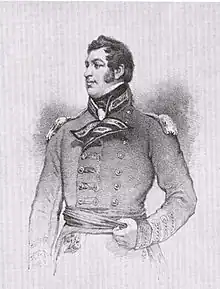The Earl of Seafield | |
|---|---|
 | |
| Lord Lieutenant of Inverness | |
| In office 2 September 1809 – 30 July 1853 | |
| Preceded by | Sir James Grant, Bt. |
| Succeeded by | The Lord Lovat |
| Personal details | |
| Born | Francis William Grant 6 March 1778 Scotland |
| Died | 30 July 1853 (aged 75) Cullen House, Moray, Scotland |
| Spouse |
Mary Anne Dunn
(m. 1811; died 1840) |
| Children | 9, including John |
| Parent(s) | Sir James Grant, 8th Baronet Jean Duff |
| Military service | |
| Allegiance | |
| Branch/service | |
| Rank | Colonel |
| Commands | Highland Fencible Corps |
Colonel Francis William Ogilvy-Grant, 6th Earl of Seafield (6 March 1778 – 30 July 1853) was a British Conservative Member of Parliament, military officer, and the 25th Chief of Clan Grant.[1] He was appointed Scottish representative peer between 1841 and 1853.
Early life
Born on 6 March 1778 as Francis William Grant, he was the second son of Sir James Grant, 8th Baronet (known as "the Good Sir James") and his wife Jean Duff. His mother was daughter of Alexander Duff, 2nd of Hatton, and Lady Anne Duff, herself a daughter of William Duff, 1st Earl Fife.[2]
Owing to the mental incapacity of his brother Ludovick Alexander Grant (and the earlier deaths of two older brothers) from 1811, he acted as Curator of the Grant Estates and those of the Seafield Earldom until he succeeded as Earl of Seafield in his own right in 1840.
Career
He began a military career when aged 15 in 1793 as a lieutenant in the Strathspey Fencibles. After time in other regiments, he was commissioned a Lieutenant Colonel in the Third Argyllshire Fencibles in 1799 and served with them as part of the Gibraltar garrison in 1800 and 1801. He received a commission as a full Colonel in the British Army in 1809 on appointment as Lord Lieutenant of Inverness. Meanwhile, 'Colonel Grant', as he was known, entered Parliament and followed a political path.[3][4][5]
In 1802, Grant was elected to the House of Commons for Elgin Burghs, a seat he held until 1806, and then represented Inverness Burghs from 1806 to 1807, Elginshire from 1807 to 1832 and Elginshire and Nairnshire from 1832 to 1840. In 1840, he succeeded his elder brother as sixth Earl of Seafield, and sat in the House of Lords as a Scottish Representative Peer from 1841 until his death in 1853. He therefore attended Parliament for a period of 50 years, voting against the Reform Act of 1832 while sitting in the Commons.[6] Sir William Fraser reported, "In politics his Lordship was a Conservative, and during his long public career loyally supported his party. He was a warm supporter of Sir Robert Peel."[7]
A member of the Church of Scotland, Grant was an ordained elder sitting in the Presbytery of Abernethy, which he also for many years represented in the General Assembly.[8]
Proprietary
Lord Seafield was noted for tree-planting. Sir William Fraser wrote that:[9]
"He was known as the largest planter of trees in Britain... the annals of the Highland and Agricultural Society of Scotland recording that in 1847, that at that date 31,686,482 young trees, Scotch firs, larch, and hardwoods, had been planted under the Earl's direction over an area of 8223 acres.... For these plantations, which were effected in the districts of Cullen, Moray, Strathspey, and Glen Urquhart, the Highland Society awarded to the Earl their gold medal."
Living mainly in Cullen House, his taste for ornamental landscape resulted in remodelling of the house, grounds and nearby town, as well as improvements to other towns within his estates.[10][5]
In 1826, at Duthil, Lord Seafield instructed the rebuilding of the Parish Church and the erection of the Seafield Mausoleum.[11]
In 1836 he gave access to his lands to representatives of the New Brunswick and Nova Scotia Land Company and expressed his opinion that some of the people of Urquhart might usefully emigrate.[9]
Personal life
On 20 May 1811, he married Mary Anne Dunn, daughter of John Charles Dunn, Esq., a wealthy East India Company merchant. They had five children.
Lord Seafield died in July 1853, aged 75, and was buried at the mausoleum at Duthil Old Parish Church and Churchyard, just outside the village of Duthil, Inverness-shire. He was succeeded in his titles by his third son, John Charles Ogilvy-Grant.[12][13][14]
His elder son, Francis William Grant was briefly MP for Inverness-shire, but predeceased Ogilvy-Grant, dying at Cullen House in 1840 whilst visiting for his mother and Ogilvy-Grant's wife's funeral.[15]
References
- ↑ List of Chiefs on the website of The Clan Grant
- ↑ Lord Strathspey (1983). A History of Clan Grant. Phillimore. p. 108.
- ↑ Fraser 1884, pp. 473–74.
- ↑ Cassillis 1911, pp. 156–58.
- 1 2 Strathspey 1983, p. 41.
- ↑ Fraser 1884, p. 474.
- ↑ Fraser 1884, p. 480.
- ↑ Fraser 1884, p. 481.
- 1 2 Fraser 1884, p. 477.
- ↑ Fraser 1884, p. 478.
- ↑ 'The New Statistical Account of Scotland' vol.13, 'County of Elgin', pub. William Blackwood & Sons Edinburgh 1834–45, p. 121: article 'The Parish of Duthil' by Rev. William Grant.
- ↑ Fraser 1884, pp. 473–83.
- ↑ Cassillis 1911, pp. 156–64.
- ↑ Strathspey, The Rt. Hon. Lord (1983). A History of Clan Grant. Chichester, Sussex: Phillimore & Co. Ltd. pp. 41–2.
- ↑ Paul, James Balfour (1904). The Scots peerage; founded on Wood's edition of Sir Robert Douglas's peerage of Scotland; containing an historical and genealogical account of the nobility of that kingdom. Edinburgh : D. Douglas. p. 489.
Works cited
- The Earl of Cassillis (1911). The Rulers of Strathspey. Inverness: The Northern Counties Newspaper and Printing and Publishing Co. Ltd.
- Fraser, Sir William (1884). The Chiefs of Grant. Edinburgh.